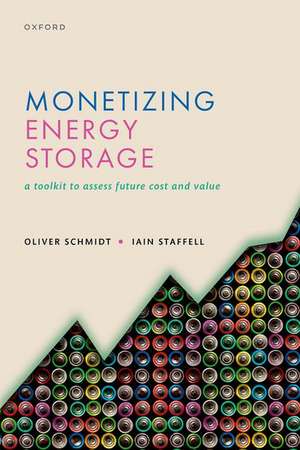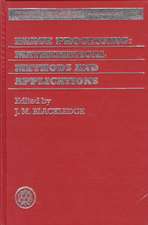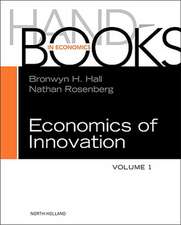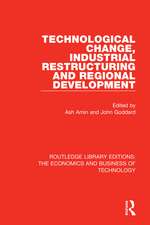Monetizing Energy Storage: A Toolkit to Assess Future Cost and Value
Autor Oliver Schmidt, Iain Staffellen Limba Engleză Hardback – 14 sep 2023
Preț: 502.75 lei
Preț vechi: 716.61 lei
-30% Nou
Puncte Express: 754
Preț estimativ în valută:
96.23€ • 104.56$ • 80.89£
96.23€ • 104.56$ • 80.89£
Carte disponibilă
Livrare economică 19-25 martie
Preluare comenzi: 021 569.72.76
Specificații
ISBN-13: 9780192888174
ISBN-10: 019288817X
Pagini: 352
Dimensiuni: 163 x 240 x 21 mm
Greutate: 0.73 kg
Editura: OUP OXFORD
Colecția OUP Oxford
Locul publicării:Oxford, United Kingdom
ISBN-10: 019288817X
Pagini: 352
Dimensiuni: 163 x 240 x 21 mm
Greutate: 0.73 kg
Editura: OUP OXFORD
Colecția OUP Oxford
Locul publicării:Oxford, United Kingdom
Recenzii
This book by Schmidt & Staffell is sure to be a game-changer for professionals entering this space. It provides the groundwork to understanding technologies, applications, cost developments, revenue potentials and conducting own assessments and comparisons. This is essential for me as an investor to navigate this complex, fast-paced energy storage industry.
An indispensable resource for anyone seeking to understand the rapidly changing landscape of energy storage, and the role it plays in complementing intermittent renewable power. While intermittency is often cited as the Achilles heel of non-dispatchable power, storage goes a long way in mitigating it. The exhibits are extremely helpful in visualizing what is often a topic mired in energy jargon, and I strongly recommend it to anyone focused on the speed and dynamics of the energy transition
This book is a great resource for anyone trying to get their head around the energy system of the future. I particularly love some of Schmidt and Staffell's charts — the collection of experience curves and the strategic gameboard by likely storage technology — they make complex trade-offs much easier to understand.
Battery storage is an essential part of the path to Net Zero Emissions, helping to ensure electricity security as renewables form the foundation of tomorrow's power systems
Now that Energy Storage is more competitive and the cost and revenue issue is getting more and more attention, this book sheds light in the jungle of stacking revenue streams and defining the right applications and the right technologies to make an Energy Storage project work. This book is a "must read" for anyone who wants to understand the Energy Storage business and a milestone to the Energy Storage sector.
Energy storage is a key technology to improve energy access to millions in Africa by supporting weak power grids and enabling remote microgrids. By skilfully navigating the complexity of storage technologies and applications with their outstanding book, Oliver Schmidt and Iain Staffell have done a huge service towards making that vision a reality. The clarity and authority of their research will build much-needed confidence among governments, entrepreneurs, NGOs and investors.
This is a must-read for industry and policy professionals. It clearly outlines the diversity of energy storage technologies available and provides real world applications and critical information for decision makers. Most importantly, it highlights the essential role of long duration energy storage (LDES) to provide flexibility and reliability to the grid. Readers will walk away with the ability to understand and assess the wide range of LDES technologies that are available today.
This is a full, detailed and comprehensive resource on how to navigate the complex world of energy storage economics from two people who know what they're talking about. Full of clear insight, data and charts.
This book is unique in spanning a broad field covering energy storage in the context of the energy transition, strategic high-level assessments, future cost estimate methodologies and project specific considerations. This coverage enables the reader to "connect the dots" between policies, strategy and implementation. Together with the practical examples that can be reproduced via the specifically created online platform the book connects theory and practice. Overall, I highly recommend it to policy makers, business leaders, project developers and engineers wanting to make informed decisions based on the delicate sensitivities in the economics of energy storage systems.
A must-read for anyone who wants to understand the critical role that energy storage is starting to play in the global energy ecosystem. The clear and concise description of technical concepts backed up by solid research and data allows the reader to develop a holistic baseline for creating their own framework to assess energy storage projects. The authors provide an unbiased and insightful assessment of the potential of each technology, as well as the challenges that must be overcome to realize their full potential. I highly recommend the book on energy storage to anyone looking to deepen their understanding of this critical field. The author's technical expertise and engaging writing style make it an essential beginner's resource for researchers, investors, policymakers, and anyone interested in the intersection of energy and sustainability.
A comprehensive text covering virtually everything useful there is to know on energy storage, it's benefits — and importantly the sensitivity to the evolution of the energy storage landscape over the next 20 years to technological improvements, discount rates and other factors. Not only do Schmidt and Staffell set this all out coherently, they also provide the reader the open-access tools to make their own analyses and to draw their own conclusions.
Monetizing Energy Storage is what I would consider essential reading for anyone that is new to the energy storage industry, or simply for those of us that have been in the industry for a while and need a refresher. This comprehensive text captures the dynamics of a complex market in a clearly laid out and easy to digest way. The book along with the associated website and worked examples, provides readers with all the tools they need to become an expert on energy storage and understand the merits of different energy storage technologies. Oliver and Iain have done a huge service to the storage industry in writing this book, I wish it had been available when I first started covering the sector.
The grid storage Bible: Schmidt and Staffell provide a well-grounded, comprehensive, insightful analysis of electricity storage across the entire value chain, full of real-world examples and complemented by a user-friendly theoretical framework with which to explore the growing role energy storage will play in systems and in markets.
Monetizing Energy Storage is THE new must-read within the booming field of storage technologies. For us as project developers, it helps us to keep an eye on the big picture, while also providing an impressive amount of well-researched detail insights in technological and market aspects. The book is red-hot at the moment, but its clarity and structure will continue to enrich the storage industry for many years to come.
Whether you are an energy storage novice or expert, "Monetizing Energy Storage" is an indispensable toolkit. It has been brilliantly conceived and written to offer critical and timely insights into possibly the most interesting enabler of sustainable energy system transformation. Schmidt & Staffell bring years of experience and research to bear in such a deep, yet accessible and practical guide. I love that they break down complex, technical concepts into easily digestible ideas.
In order to mitigate climate change, a rapid and deep transition to net-zero emission energy systems is needed. Renewable energy will play a critical role in this transition, and as a result, energy storage will be among the most critical factors that determine how easy or difficult our pathways to net zero will be. In this context, this book is extremely relevant, providing a valuable resource for practitioners, policymakers, and academics interested in the deployment potential and economic value of energy storage. The book discusses all relevant aspects and its interactive online tool enables easy reproduction of the presented analyses with custom data. It is a must-read for those interested in understanding how energy storage can play a role in accelerating the energy transition.
Energy storage is the key to unlocking access to many low carbon energy technologies. For practitioners and academics alike, this book is the go-to resource for understanding the principles and practicalities of energy storage in its many forms. The clear coverage of economics and finance, at both the technology and system level, is exemplary in terms of academic rigour set in a real-world context.
For more than a decade, I have been searching for a book that combines the science, technology, economics, and financial aspects of energy storage - and now I have found it. Oliver and Iain's book is perfect for readers interested in understanding how energy storage can capture value as the world accelerates into the clean energy transition. It is easy to digest yet highly technical; it uses many examples, and has an accompanying website to play around with the numbers. This is a great resource for energy storage technology scientists transitioning into applied systems work, for industry practitioners who want to understand how the technology affects use cases and value, and for policymakers who want to encourage investments in storage. I will definitely use this book for my graduate course on energy storage.
This book is ground-breaking. Schmidt and Staffell bring structure to the complex set of metrics used to describe the finances of energy storage. They use latest data to bring these metrics to life and derive key insights for the industry. More importantly, they empower readers to perform their own analyses. This is an essential read for all professionals and academics who want to engage with the industry.
Coming from two certified experts in their fields, this book is unique, remarkable and outstanding. It is both the ultimate Swiss Army knife of energy storage applied economics and the golden compass for storage investment. Incredibly well written, conceived, documented and illustrated; a great volume contributing to the Energy Transition Encyclopedia of the 21 Century. In my 30 years of electricity economic research I have not seen such a wonderful book: so well-conceived, so comprehensive, so useful: really great!
An indispensable resource for anyone seeking to understand the rapidly changing landscape of energy storage, and the role it plays in complementing intermittent renewable power. While intermittency is often cited as the Achilles heel of non-dispatchable power, storage goes a long way in mitigating it. The exhibits are extremely helpful in visualizing what is often a topic mired in energy jargon, and I strongly recommend it to anyone focused on the speed and dynamics of the energy transition
This book is a great resource for anyone trying to get their head around the energy system of the future. I particularly love some of Schmidt and Staffell's charts — the collection of experience curves and the strategic gameboard by likely storage technology — they make complex trade-offs much easier to understand.
Battery storage is an essential part of the path to Net Zero Emissions, helping to ensure electricity security as renewables form the foundation of tomorrow's power systems
Now that Energy Storage is more competitive and the cost and revenue issue is getting more and more attention, this book sheds light in the jungle of stacking revenue streams and defining the right applications and the right technologies to make an Energy Storage project work. This book is a "must read" for anyone who wants to understand the Energy Storage business and a milestone to the Energy Storage sector.
Energy storage is a key technology to improve energy access to millions in Africa by supporting weak power grids and enabling remote microgrids. By skilfully navigating the complexity of storage technologies and applications with their outstanding book, Oliver Schmidt and Iain Staffell have done a huge service towards making that vision a reality. The clarity and authority of their research will build much-needed confidence among governments, entrepreneurs, NGOs and investors.
This is a must-read for industry and policy professionals. It clearly outlines the diversity of energy storage technologies available and provides real world applications and critical information for decision makers. Most importantly, it highlights the essential role of long duration energy storage (LDES) to provide flexibility and reliability to the grid. Readers will walk away with the ability to understand and assess the wide range of LDES technologies that are available today.
This is a full, detailed and comprehensive resource on how to navigate the complex world of energy storage economics from two people who know what they're talking about. Full of clear insight, data and charts.
This book is unique in spanning a broad field covering energy storage in the context of the energy transition, strategic high-level assessments, future cost estimate methodologies and project specific considerations. This coverage enables the reader to "connect the dots" between policies, strategy and implementation. Together with the practical examples that can be reproduced via the specifically created online platform the book connects theory and practice. Overall, I highly recommend it to policy makers, business leaders, project developers and engineers wanting to make informed decisions based on the delicate sensitivities in the economics of energy storage systems.
A must-read for anyone who wants to understand the critical role that energy storage is starting to play in the global energy ecosystem. The clear and concise description of technical concepts backed up by solid research and data allows the reader to develop a holistic baseline for creating their own framework to assess energy storage projects. The authors provide an unbiased and insightful assessment of the potential of each technology, as well as the challenges that must be overcome to realize their full potential. I highly recommend the book on energy storage to anyone looking to deepen their understanding of this critical field. The author's technical expertise and engaging writing style make it an essential beginner's resource for researchers, investors, policymakers, and anyone interested in the intersection of energy and sustainability.
A comprehensive text covering virtually everything useful there is to know on energy storage, it's benefits — and importantly the sensitivity to the evolution of the energy storage landscape over the next 20 years to technological improvements, discount rates and other factors. Not only do Schmidt and Staffell set this all out coherently, they also provide the reader the open-access tools to make their own analyses and to draw their own conclusions.
Monetizing Energy Storage is what I would consider essential reading for anyone that is new to the energy storage industry, or simply for those of us that have been in the industry for a while and need a refresher. This comprehensive text captures the dynamics of a complex market in a clearly laid out and easy to digest way. The book along with the associated website and worked examples, provides readers with all the tools they need to become an expert on energy storage and understand the merits of different energy storage technologies. Oliver and Iain have done a huge service to the storage industry in writing this book, I wish it had been available when I first started covering the sector.
The grid storage Bible: Schmidt and Staffell provide a well-grounded, comprehensive, insightful analysis of electricity storage across the entire value chain, full of real-world examples and complemented by a user-friendly theoretical framework with which to explore the growing role energy storage will play in systems and in markets.
Monetizing Energy Storage is THE new must-read within the booming field of storage technologies. For us as project developers, it helps us to keep an eye on the big picture, while also providing an impressive amount of well-researched detail insights in technological and market aspects. The book is red-hot at the moment, but its clarity and structure will continue to enrich the storage industry for many years to come.
Whether you are an energy storage novice or expert, "Monetizing Energy Storage" is an indispensable toolkit. It has been brilliantly conceived and written to offer critical and timely insights into possibly the most interesting enabler of sustainable energy system transformation. Schmidt & Staffell bring years of experience and research to bear in such a deep, yet accessible and practical guide. I love that they break down complex, technical concepts into easily digestible ideas.
In order to mitigate climate change, a rapid and deep transition to net-zero emission energy systems is needed. Renewable energy will play a critical role in this transition, and as a result, energy storage will be among the most critical factors that determine how easy or difficult our pathways to net zero will be. In this context, this book is extremely relevant, providing a valuable resource for practitioners, policymakers, and academics interested in the deployment potential and economic value of energy storage. The book discusses all relevant aspects and its interactive online tool enables easy reproduction of the presented analyses with custom data. It is a must-read for those interested in understanding how energy storage can play a role in accelerating the energy transition.
Energy storage is the key to unlocking access to many low carbon energy technologies. For practitioners and academics alike, this book is the go-to resource for understanding the principles and practicalities of energy storage in its many forms. The clear coverage of economics and finance, at both the technology and system level, is exemplary in terms of academic rigour set in a real-world context.
For more than a decade, I have been searching for a book that combines the science, technology, economics, and financial aspects of energy storage - and now I have found it. Oliver and Iain's book is perfect for readers interested in understanding how energy storage can capture value as the world accelerates into the clean energy transition. It is easy to digest yet highly technical; it uses many examples, and has an accompanying website to play around with the numbers. This is a great resource for energy storage technology scientists transitioning into applied systems work, for industry practitioners who want to understand how the technology affects use cases and value, and for policymakers who want to encourage investments in storage. I will definitely use this book for my graduate course on energy storage.
This book is ground-breaking. Schmidt and Staffell bring structure to the complex set of metrics used to describe the finances of energy storage. They use latest data to bring these metrics to life and derive key insights for the industry. More importantly, they empower readers to perform their own analyses. This is an essential read for all professionals and academics who want to engage with the industry.
Coming from two certified experts in their fields, this book is unique, remarkable and outstanding. It is both the ultimate Swiss Army knife of energy storage applied economics and the golden compass for storage investment. Incredibly well written, conceived, documented and illustrated; a great volume contributing to the Energy Transition Encyclopedia of the 21 Century. In my 30 years of electricity economic research I have not seen such a wonderful book: so well-conceived, so comprehensive, so useful: really great!
Notă biografică
Oliver Schmidt works as management consultant in the clean energy industry. He has previous experience as project manager at the strategy consulting and financial transaction advisory firm Apricum, where he supported top management with strategic advice in the energy storage, solar PV and hydrogen industries. Oliver also worked as an energy analyst at the International Energy Agency and as a management consultant at E.ON. He has a PhD on the future cost and value of energy storage from Imperial College London. His background is in mechanical engineering and renewable energy, which he studied at Imperial and the Swiss Federal Institute of Technology (ETH).Iain Staffell is a multi-disciplinary scientist holding degrees in Physics, Chemical Engineering and Economics. He is a Senior Lecturer in Sustainable Energy at Imperial College London, and previously worked at the University of Birmingham and Imperial College Business School. He has taught for ten years and authored 100 papers across energy economics, engineering, and energy systems modelling. He champions open-source science and is a developer of the Renewables.ninja, Demand.ninja, and EnergyStorage.ninja web platforms.


















